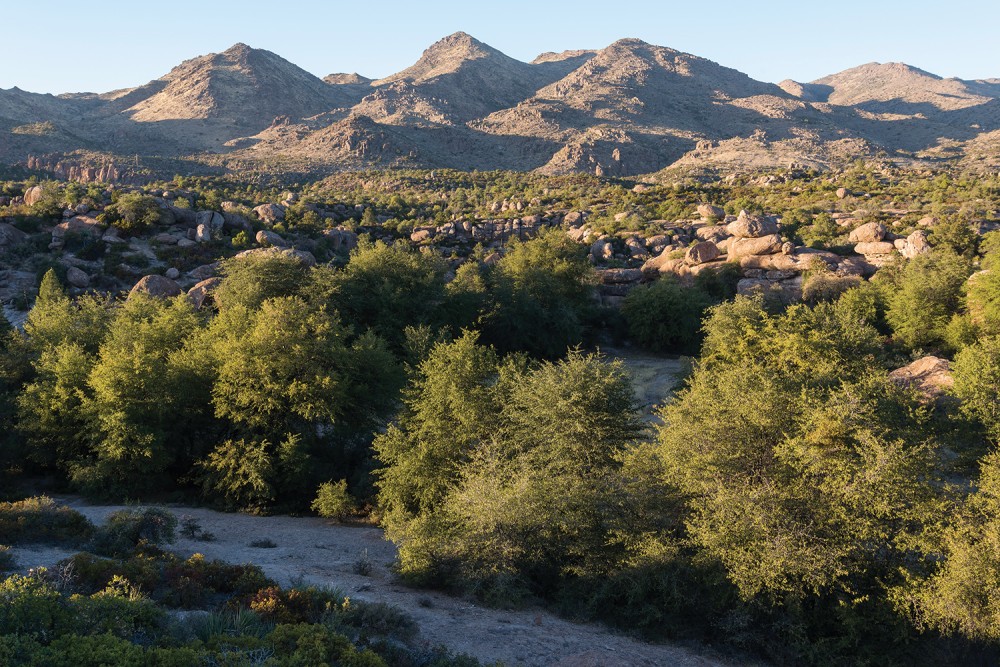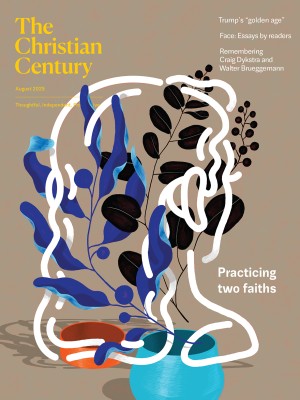Apache Stronghold’s rooted resistance
The fight to protect Oak Flat is not just about a single holy site. It is about recovering our bond with the land.

Oak Flat, in Arizona, a sacred place for the Apache people, is under direct threat from Resolution Copper and the Trump administration. (Photo by Elias Butler / Sinaguawiki / Creative Commons)
Perched 4,000 feet above the Sonoran Desert in Arizona, Chí’chil Biłdagoteel, or Oak Flat, is a mountain refuge where Apache people have danced in ceremony since time immemorial. When the sun rises at Oak Flat, it shines through mountaintops thick with massive red boulders, and the leaves of ancient oaks catch the first light over the ground. I hear the quiet voice of an uncolonized God speaking at Oak Flat. The Spirit is present in the lush tree-lined canyons, as well as in the drumming during the Sunrise Ceremony, held here when Apache girls become women.
If the US government has its way, this sacred site will soon be converted into a massive copper mine. The Trump administration has announced an August 19 transfer of the land to Resolution Copper, a joint venture by two of the world’s largest mining corporations: Australian company BHP and British-Australian company Rio Tinto. If the mine is built, in the course of 40 years Resolution Copper is expected to export more than 40 billion pounds of copper ore to China for processing.
Read our latest issue or browse back issues.
Apache Stronghold is fighting to save Oak Flat. After Congress authorized the Oak Flat land transfer, in 2021 the nonprofit group sued to stop the project on religious freedom grounds. Last year it lost in federal circuit court and appealed to the US Supreme Court.
On May 27, in a 7–2 vote, the court decided against hearing Apache Stronghold’s appeal. Neil Gorsuch’s dissent, which was joined by Clarence Thomas, argues that the decision openly discriminates against non-Christian religious practice. “Just imagine if the government sought to demolish a historic cathedral on so questionable a chain of legal reasoning,” Gorsuch wrote. “I have no doubt that we would find that case worth our time.”
Apache Stronghold’s vision stretches beyond protecting Oak Flat. The group invites us to strip away the layers of colonization that separate us from seeing, hearing, and touching the sacred in the land. It welcomes people of all faiths to join in recovering the relationship with the nonhuman world around us. “Here we still understand the importance of the connection to Mother Earth,” says Wendsler Nosie in an online video. “The best teacher is the water, the tree, the wind . . . it triggers this spiritual awakening.” The bioethicist and Apache Stronghold leader describes how this connection has been taken away from all of us by colonization and replaced by capitalist extraction and illusions that destroy the environment and the people.
For the last two years, I’ve been working with Apache Stronghold as part of the Chí’chil Biłdagoteel Oak Flat Accompaniment team. Our members have provided physical and spiritual accompaniment to Apache Stronghold as it faces threats, harassment, and gunfire in retaliation for its work to protect Oak Flat, and we’ve held training sessions to prepare others for this work. Since May 2023, we have maintained a team of two people at Oak Flat. This team has camped at the site, traveled with Apache Stronghold members, and, most importantly, prayed. We have also helped recruit congregations across the continent to include Apache Stronghold in their prayer lives.
Again and again, I’ve heard Nosie challenge us, as Christians, to consider when our ancestors were cut off from their connection with the land. He tells us how Apache spiritual leaders like Silas John Edwards found ways to protect and sustain their relationships with the sacred on the Apache reservations. Apache prayer and ceremony are inextricably connected with specific geographic features. It is easy for us to forget that the spiritual practice and lifeways of all of our ancestors used to be rooted in specific places and particular watersheds. Nosie suggests that church buildings are one way that the Christian tradition has kept the wild and holy alive in a time when the nonhuman world has mainly been seen as something to be commodified and sold.
These conversations have encouraged me to revisit some of the stories of the rooted relationship with Mother Earth that was once part of our sacred tradition but has long been marginalized or ignored. These stories are richly strewn through the Hebrew Bible if we have eyes to see them. Scholar Wes Howard-Brook calls this tradition “the religion of creation,” which “the religion of empire” is constantly trying to suppress and destroy.
In Messianism Against Christology, James Perkinson argues that again and again we see Indigenous and rooted ways of being blossoming to resist empire. According to the theologian, the seminal moment of this conflict is when Cain murders Abel and Abel’s blood cries out to God from the ground (Gen. 4:1–16). Cain goes on to found city-states, while nomadic peoples with flocks like Abel’s are forced farther and farther into wilderness areas.
Moses, after his encounter in the wilderness with the burning bush (Exod. 3:1–4:17), leads the Israelites out of Egypt and to Mount Sinai. In the inverse of Cain’s trajectory, he escapes the imperial center to receive manna and water from boulders (Exod. 16:1–36; Num. 11:1–9; Exod. 17:1–7). Prophets such as Elijah also follow this rewilding path back to Mother Earth when they hide from angry kings and are guided and nourished by the land: Elijah hears a quiet, gentle sound in the cave where he finds refuge (1 Kings 19:11–13), and ravens bring him food in the Kerith Ravine (1 Kings 17:2–7).
Jesus follows this same anti-colonial path back to the wilderness after his baptism. Like the people of Israel after Egypt, this is his time for rewilding. This is when he peels back the layers of what Roman rule has done, not only to him but to his people. In The Four Vision Quests of Jesus, Choctaw Episcopal bishop Steven Charleston says that “Jesus, as a ‘Son of the People,’ walks behind the Spirit into the Wilderness, not as a single mystic going out for a private audience with God, but as the representative of the whole nation going out to speak to their parent God.”
Jesus goes into the wilderness immersed in and embodying the colonial conflict his people have been immersed in for centuries: prophets of the wilderness, who repudiated injustice and listened to Mother Earth, standing up to kings and imperial bureaucrats, who justified domination and commodification.
In the wilderness, Jesus lives among unhewn stones—living stones. Perkinson points out that the biblical term for Jesus’ job (tekton) means craftsperson, not carpenter. Jesus probably would have been working with stone, likely to build Roman buildings. “In his post-baptism wilderness encounters,” writes Perkinson, “he is having to relearn rock no longer as mere ‘resource’ at the raw end of his hammer, but as Elder and Provider and Watcher.”
Jesus comes out of the wilderness decisively choosing the side of the prophets. His whole ministry focuses relentlessly on justice and peace for the marginalized. After Jesus’ death and resurrection, the apostles continue on this path. In the sermon of Stephen, which prompts his execution by stoning, his conclusion points to a time before the temple, when God repudiated buildings: “Heaven is my throne, and the earth is my footstool. What kind of house will you build for me, says the Lord, or what is the place of my rest? Did not my hand make all these things?” (Acts 7:49–50, quoting Isa. 66:1–2).
As minister and activist Bill Wylie-Kellermann says, “It’s the loaded punch line to recounting a history of Israel, but always with an eye to wildness—Abraham out of empire tenting in the land of promise, Moses relearning wilderness as holy ground from the bush that burns.” He points out that Stephen’s closing quote from Isaiah stands in for the prophet Nathan’s direct rebuke of David’s temple aspirations (2 Sam. 7:4–17). Stephen explicitly connects God’s repudiation of buildings to contain her with the prophets who were always rising up to cry out for the widow, the alien, the orphan, and the wilderness itself.
Fighting alongside Apache Stronghold is not just about saving Oak Flat. It is about recovering the rootedness of our ancestors: everyone beneath their vine and fig tree, in peace and unafraid (Mic. 4:4).
As our civilization barrels toward ecological collapse, this is our existential struggle: Will humanity survive? Our tradition has the seeds of a different way strewn abundantly throughout the stories of the Hebrew Bible and the New Testament. The seeds are Naboth’s “ancestral inheritance” (1 Kings 21:3), Miriam’s “mighty waters” (Exod. 15:10), Shiphrah and Puah’s stories of vigorous childbirth (Exod. 1:15–21), and Elijah’s ravens. These are stories of a once-rooted people surviving the end of their world (see Charleston’s book We Survived the End of the World for more).
Thousands of years of imperial reading have warped our ability to water those seeds. As Kelly Brown Douglas says in The Black Christ, “slaveholding Christianity” systematically distorted our scriptures to make them compatible with owning other human beings as commodities. It also taught us to see nature as a commodity from which to take profit.
When Apache Stronghold filed its case at the Supreme Court last September, Mennonite pastor Carol Rose joined other speakers in support of the case. Rose has been a key leader in the Oak Flat Accompaniment. On the towering steps of the Supreme Court building, she said, “In order to impress and intimidate, the builders of empire went into the mountains and cut out living rock. They brought these dead bones to make their temples to power and death. Yet, even here, there is still real power to connect in the soil of Mother Earth, to trees whose roots go deep back into time and forward into the future and to each other. This is the community we choose today.”
We have to tend these seedlings now so that our descendants have blossoms to smell and fruit to eat. Apache Stronghold invites us to water the seeds of our rooted ancestors and reconsider the places we hold as sacred.





